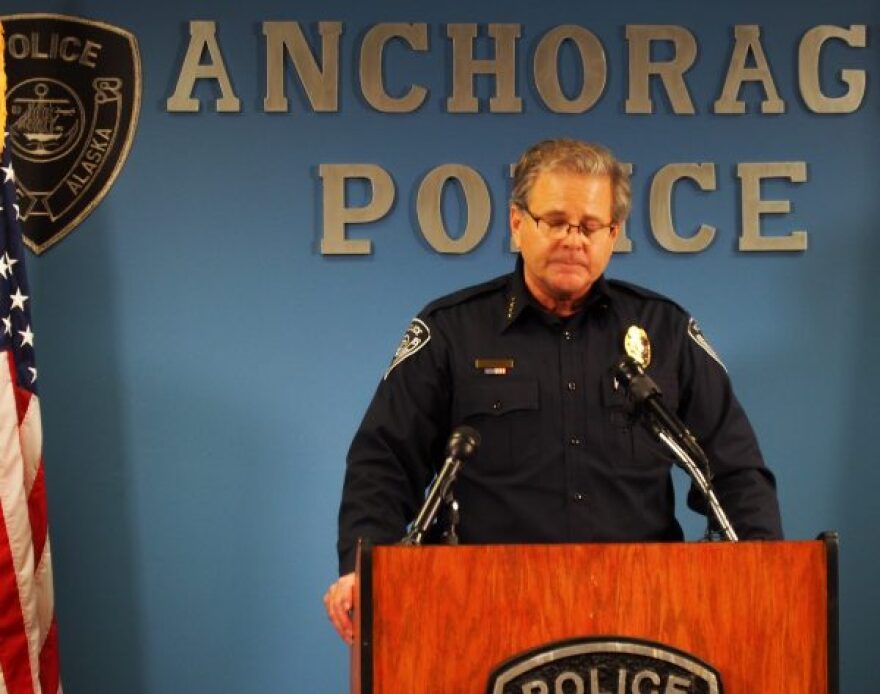It's been a deadly year in Alaska's largest city, with 34 homicide victims so far -- more than in any previous year on record. It comes on the heels of 2015, which also saw an exceptionally high number of violent deaths. But without any single factor responsible for the surge in homicides, there's no clear solution to the problem.
Throughout this year, news reports from Anchorage have been particularly morbid, with frequent stories about shootings and homicides.
For months, police and elected officials have been active in trying to get out a message to the public that, even amid the grim headlines, Anchorage remains a relatively safe place.
During an interview in August, Police Chief Chris Tolley explained that the most consistent factor in homicides was the presence of drugs and alcohol.
"Most of these incidents are things that went too far," Tolley explained. "Disputes over different things, over drugs or things like that."
Tolley, along with as spokespeople for the Anchorage Police Department and mayor's administration, has stressed that there is no one cause behind the last two years of high homicide numbers. Deaths from domestic violence are above average this year. The number of young people under the age of 21 involved in shootings is dramatically up, alarming police. And five deaths have been connected to the same gun used by James Dale Ritchie, suggesting a pattern of targeted killings. Ritchie himself died in a shoot-out with an APD officer, one of four men killed by police in Anchorage since the start of the year -- police shooting figures are not included in how the city reports homicide statistics.
Looming over conversations about violence is the question of whether Anchorage has a gang problem. In an email, a APD spokesperson Renee Oistad wrote that investigators "have NOT linked gang activity to the increased number of homicides."
Speaking on Talk of Alaska in September, Tolley described a gang presence in Anchorage, but stopped short of connecting it to the high number of homicides.
"We have seen some activity where there are gang links," Tolley said. "But not the same sort of territorial and full-blown gang activity that these other cities experience. Most of it's just through affiliation."
This characterization can seem like semantics, particularly when other law enforcement agencies are publicly pointing to gangs as a source of increased violence and crime. On Dec. 28, the U.S. Attorney's office in Anchorage announced the final sentence coming down in an investigation that led to convictions against 12 individuals for crimes stemming from gang activity. According to federal officials, the "Fairview MOB" was linked to a chapter of the Bloods in California, and sentences ranging from eight months to 10 years were handed down for crimes involving drug trafficking, money laundering and firearms possession.
Though no one from the FBI's Anchorage office was available to comment, Special Agent Mike Watson described how the lucrative drug market in Anchorage and Alaska fuels gang activity during a recent interview with KTVA News.
"People from the lower-48 or other areas can come up here and make a lot of money selling narcotics. With that, we'll get people up here part-time from some of the lower-48 gangs," Watson said.
But researchers caution against scapegoating any one particular cause to explain this year's homicides. Troy Payne is an associate professor of justice at the University of Alaska Anchorage.
"Just knowing the number of crimes that occur really doesn't help you to figure out what the problem is," Payne said.
According to a recent report from the Alaska Justice Statistical Analysis Center, in the last three decades, Anchorage's homicide rate has averaged 7.4 deaths per 100,000 people. This year it's 11.4. That's still a fraction of what larger, more violent American cities face, but it does represent a tripling from the rate in Anchorage during 2014.
Prof. Payne shares APD's view that this increase is from a perfect storm of several different factors all converging. He added that without more thorough information about the individual cases it's speculation to say whether the last two years are outliers or an emerging trend.
"We don't know if that is just random fluctuation of the number of homicides and the homicide rate, or whether there is a systemic, repeatable problem that we can apply solutions to," Payne said. "We simply just don't know that."
Police only have so much control over violent crime, according to Payne, who doesn't believe the homicide rate should be the lone metric used for assessing a police department. The clearance rate for homicide cases, for example, is 90 percent this year according to Oistad at APD. That's up dramatically from where it wasdecades ago.
The mayor's administration and community advocates have expressed views similar to Payne. Some have pointed to reduced police staffing in previous years, as well as cuts to social services and community programming as factors contributing to an overall increase in crime within the municipality over the last year.

